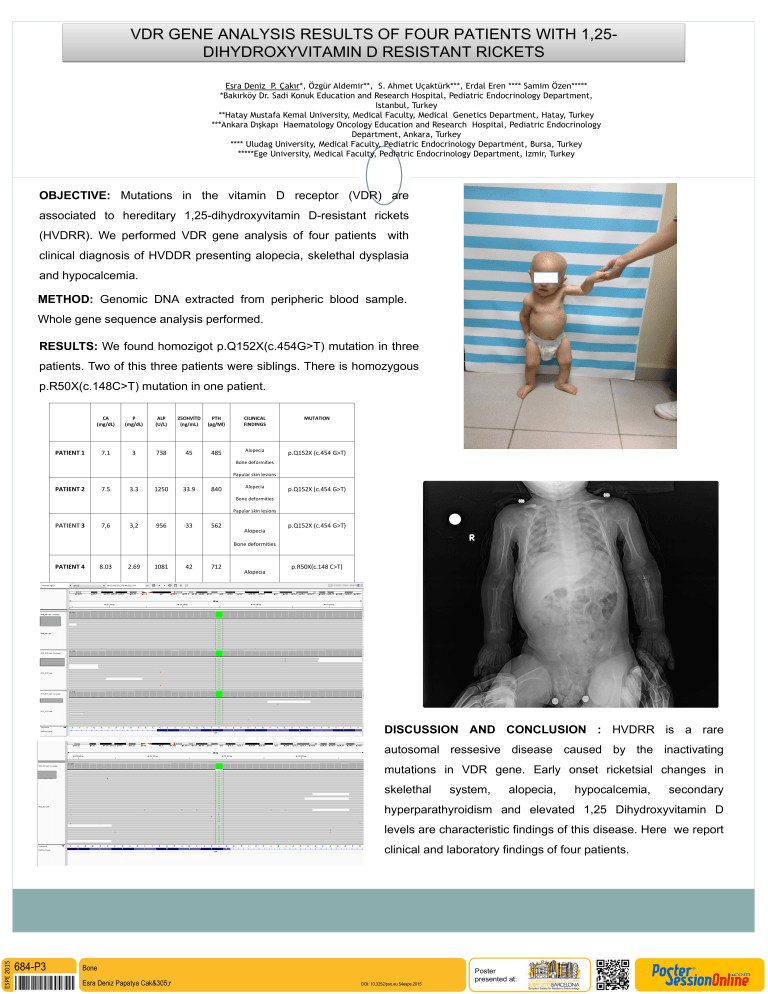
VDR GENE ANALYSIS RESULTS OF FOUR PATIENTS WITH 1,25DIHYDROXYVITAMIN D RESISTANT RICKETS
Esra Deniz P. Çakır*, Özgür Aldemir**, S. Ahmet Uçaktürk***, Erdal Eren **** Samim Özen*****
*Bakırköy Dr. Sadi Konuk Education and Research Hospital, Pediatric Endocrinology Department,
Istanbul, Turkey
**Hatay Mustafa Kemal University, Medical Faculty, Medical Genetics Department, Hatay, Turkey
***Ankara Dışkapı Haematology Oncology Education and Research Hospital, Pediatric Endocrinology
Department, Ankara, Turkey
**** Uludag University, Medical Faculty, Pediatric Endocrinology Department, Bursa, Turkey
*****Ege University, Medical Faculty, Pediatric Endocrinology Department, Izmir, Turkey
OBJECTIVE: Mutations in the vitamin D receptor (VDR) are
associated to hereditary 1,25-dihydroxyvitamin D-resistant rickets
(HVDRR). We performed VDR gene analysis of four patients with
clinical diagnosis of HVDDR presenting alopecia, skelethal dysplasia
and hypocalcemia.
METHOD: Genomic DNA extracted from peripheric blood sample.
Whole gene sequence analysis performed.
RESULTS: We found homozigot p.Q152X(c.454G>T) mutation in three
patients. Two of this three patients were siblings. There is homozygous
p.R50X(c.148C>T) mutation in one patient.
CA
(mg/dL)
P
(mg/dL)
ALP
(U/L)
25OHVİTD
(ng/mL)
PTH
(pg/Ml)
CILINICAL
FINDINGS
MUTATION
7.1
3
738
45
485
Alopecia
p.Q152X (c.454 G>T)
PATIENT 1
Bone deformities
Papular skin lesions
PATIENT 2
7.5
3.3
1250
33.9
840
Alopecia
p.Q152X (c.454 G>T)
Bone deformities
Papular skin lesions
PATIENT 3
7,6
3,2
956
33
562
Alopecia
p.Q152X (c.454 G>T)
Bone deformities
PATIENT 4
8.03
2.69
1081
42
712
Alopecia
p.R50X(c.148 C>T)
Bone deformities
DISCUSSION AND CONCLUSION : HVDRR is a rare
autosomal ressesive disease caused by the inactivating
mutations in VDR gene. Early onset ricketsial changes in
skelethal
system,
alopecia,
hypocalcemia,
secondary
hyperparathyroidism and elevated 1,25 Dihydroxyvitamin D
levels are characteristic findings of this disease. Here we report
ESPE 2015
clinical and laboratory findings of four patients.
684-P3
Bone
Esra Deniz Papatya Cak&305;r
DOI: 10.3252/pso.eu.54espe.2015
Poster
presented at:
